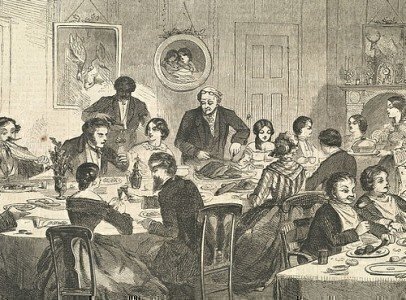Do you think the Founding Fathers observed Thanksgiving by eating turkey, dressing, and green bean casserole? In reality, there were a few things on the menu we wouldn’t see today, including an extinct bird and some slimy fish.
 For example, turkey is the centerpiece of the modern Thanksgiving meal, but back in Colonial days, Ben Franklin’s favorite bird may have been just one of several fowl on the menu.
For example, turkey is the centerpiece of the modern Thanksgiving meal, but back in Colonial days, Ben Franklin’s favorite bird may have been just one of several fowl on the menu.
More likely, goose or duck was the bird of choice, with swan and passenger pigeon as likely treats, along with wild turkey.
The passenger pigeon, in particular, was around for the holidays. Pigeon pie was a popular side dish.
The pigeons were combined with other meats and stock and baked in a puff pastry. But don’t expect a Passenger Pigeon Pie on your local buffet: The birds were hunted to their extinction in a quest for cheap meat. The last one died in 1914.
And how about some eels with your cranberry sauce?
That wouldn’t likely be accurate historically, since cranberry sauce was invented after the first Thanksgiving.
The eels were probably a slimy side course at the 17th-century version of the Thanksgiving feast. We’re not sure how the eels were prepared, but they were plentiful. Another possible side dish was seal.
But the most likely centerpiece of the first Thanksgiving meals was deer. Venison was common, and a whole deer could feed a lot of people.
Pork wasn’t used at the time for Thanksgiving, although colonist had brought pigs with them. So there was no Thanksgiving ham.
Other dishes included corn, beans, onions, and pumpkin. The pumpkin was probably stewed, since pumpkin pie wasn’t around.
Also absent from the first Thanksgiving meals were any potato products, chicken, corn on the cob, and eggs.
In the time of George Washington, Thanksgiving was observed as an unofficial national holiday, often in early December.
The date really depended on when crops were harvested and the availability of food for the feast.
Two accounts from the late 1700s show turkey and pumpkin pie showing up on the menu.
In a letter written by Juliana Smith in 1779, a typical New England Thanksgiving feast is detailed: Venison is the main course, but only because roast beef has been rationed during the Revolutionary War. Cider is also served in place of wine due to the war effort. Other courses include pigeon pies, turkey, goose, onions in cream, mincemeat pie, pumpkin pie, and yes, potatoes.
Nine years later, a prominent surgeon described a typical Thanksgiving meal in his diary. Mason Finch Cogswell said that turkey, pork, pumpkin pie, and apple pie were the main features of the feast.
Early 19th-century accounts from New England indicate that geese, chicken, turnips, and pumpkin pie were the prominent menu items in Connecticut, with a lot of cider, brandy, and whiskey in the mix.
It wasn’t until later in the century that turkey became the fowl of choice on the holiday. But one account from Massachusetts in 1836 makes it clear that one item was mandatory on the menu.
“Then come puddings and pies...among the most prominent of which is that savory dish, peculiar to New England--that sine qua non of a Thanksgiving dinner--the well filled, deep and spacious pumpkin pie,” said the New-Bedford Mercury.
One thing that was a late addition to the Thanksgiving dinner table was the fork.
In the time of the Pilgrims, there weren’t forks, and they were just being integrated into the dinner table by the time of the Constitutional Convention in 1787.
So this Thanksgiving, remember to be grateful for your modern spread of delicious food--and your handy fork.







